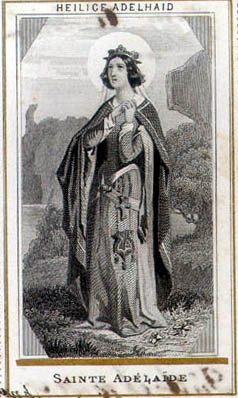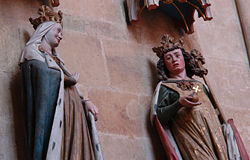Difference between revisions of "Adelaide of Italy" - New World Encyclopedia
m (→References) |
m (→External links) |
||
| Line 51: | Line 51: | ||
==External links== | ==External links== | ||
All links retrieved October 30, 2008. | All links retrieved October 30, 2008. | ||
| + | * [http://www.womeninworldhistory.com/adelaide.html Adelaide of Italy] ''womeninworldhistory.com'' | ||
* [http://www.genealogie-mittelalter.de/deutschland_koenige_2/adelheid_von_burgund_999_rudolfinger_hugoniden_liudolfinger/adelheid_von_burgund_999.html Genealogie-Mittelalter: "Adelheid von Burgund"] (In German) ''genealogie-mittelalter.de'' | * [http://www.genealogie-mittelalter.de/deutschland_koenige_2/adelheid_von_burgund_999_rudolfinger_hugoniden_liudolfinger/adelheid_von_burgund_999.html Genealogie-Mittelalter: "Adelheid von Burgund"] (In German) ''genealogie-mittelalter.de'' | ||
Revision as of 00:12, 31 October 2008
- For another Saint Adelaide, see Adelaide, Abbess of Vilich.
| Saint Adelaide | |
|---|---|
| Born | 931-932 in Burgundy, France |
| Died | December 16 999 in Seltz, Alsace |
| Venerated in | Catholic Church |
| Canonized | 1097
by Pope Urban II |
| Feast | December 16 |
| Attributes | empress dispensing alms and food to the poor, often beside a ship |
| Patronage | abuse victims; brides; empresses; exiles; in-law problems; parenthood; parents of large families; princesses; prisoners; second marriages; step-parents; widows |
Saint Adelaide of Italy, also called Adelaide of Burgundy (931/932 – 16 December 999) was perhaps the most prominent European woman of the 10th century.
She was the daughter of Rudolf II of Burgundy and Bertha of Swabia. Her first marriage, at the age of fifteen, was to the son of her father's rival in Italy, Lothair II, the nominal King of Italy; the union was part of a political settlement designed to conclude a peace between her father and Hugh of Provence, the father of Lothair. They had a daughter, Emma of Italy.
The Calendar of Saints states that her first husband was poisoned by the holder of real power, his successor, Berengar of Ivrea, who attempted to cement his political power by forcing her to marry his son, Adalbert; when she refused and fled, she was tracked down and imprisoned for four months at Como. She escaped to the protection, at Canossa, of Adalbert Atto, where she was besieged by Berengar. She managed to send an emissary to throw herself on the mercy of Otto the Great of Germany. His brothers were equally willing to save the heiress of Italy, but Otto got an army into the field: they subsequently met at the old Lombard capital of Pavia and were married in 951; he was crowned Emperor in Rome, 2 February 962 by Pope John XII, and, most unusually, she was crowned Empress at the same ceremony. Among their children, four lived to maturity: Henry, born in 952; Bruno, born 953; Matilda, Abbess of Quedlinburg, born about 954; and Otto II, later Holy Roman Emperor, born 955.
In Germany, the crushing of a revolt in 953 by Liudolf, Otto's son by his first marriage, cemented the position of Adelaide, who retained all her dower lands. She accompanied Otto in 966 on his third expedition to Italy, where she remained with him for six years.
When her husband Otto I died in 973 he was succeeded by their son Otto II, and Adelaide for some years exercised a powerful influence at court. Later, however, her daughter-in-law, the Byzantine princess Theophano, turned her husband Otto II against his mother, and she was driven from court in 978; she lived partly in Italy, and partly with her brother Conrad, king of Burgundy, by whose mediation she was ultimately reconciled to her son; in 983 Otto appointed her his viceroy in Italy. However, Otto died the same year, and although both mother and grandmother were appointed as co-regents for the child-king, Otto III, Theophano forced Adelaide to abdicate and exiled her. When Theophano died in 991, Adelaide was restored to the regency of her grandson. She was assisted by Willigis, bishop of Mainz. In 995 Otto III came of age, and Adelaide was free to devote herself exclusively to works of charity, notably the foundation or restoration of religious houses.
Adelaide had long entertained close relations with Cluny, then the center of the movement for ecclesiastical reform, and in particular with its abbots Majolus and Odilo. She retired to a monastery she had founded in c. 991 at Selz in Alsace. Though she never became a nun, she spent the rest of her days there in prayer. On her way to Burgundy to support her nephew Rudolf III against a rebellion, she died at Selz Abbey on December 16, 999, days short of the millennium she thought would bring the Second Coming of Christ. She had constantly devoted herself to the service of the church and peace, and to the empire as guardian of both; she also interested herself in the conversion of the Slavs. She was thus a principal agent—almost an embodiment—of the work of the Catholic Church during the Early Middle Ages in the construction of the religion-culture of western Europe. Her feast day, December 16, is still kept in many German dioceses.
| Preceded by: Edith of Wessex |
German Queen 951–961 |
Succeeded by: Theophanu |
| Preceded by: Vacant Title last held by Bertila of Spoleto |
Empress of the Holy Roman Empire 962–973 |
ReferencesISBN links support NWE through referral fees
- Attwater, Donald and Catherine Rachel John. The Penguin Dictionary of Saints. 3rd edition. New York: Penguin Books, 1993. ISBN 0-140-51312-4.
- Coulson, John ed. The Saints: A Concise Biographical Dictionary. Hawthorn Books, 1960.
- This article incorporates text from the Encyclopædia Britannica Eleventh Edition, a publication now in the public domain.
External links
All links retrieved October 30, 2008.
- Adelaide of Italy womeninworldhistory.com
- Genealogie-Mittelalter: "Adelheid von Burgund" (In German) genealogie-mittelalter.de
Credits
New World Encyclopedia writers and editors rewrote and completed the Wikipedia article in accordance with New World Encyclopedia standards. This article abides by terms of the Creative Commons CC-by-sa 3.0 License (CC-by-sa), which may be used and disseminated with proper attribution. Credit is due under the terms of this license that can reference both the New World Encyclopedia contributors and the selfless volunteer contributors of the Wikimedia Foundation. To cite this article click here for a list of acceptable citing formats.The history of earlier contributions by wikipedians is accessible to researchers here:
The history of this article since it was imported to New World Encyclopedia:
Note: Some restrictions may apply to use of individual images which are separately licensed.

